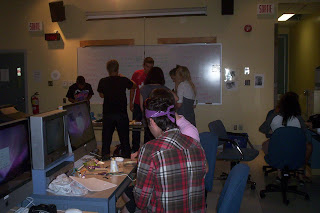We started with everyone taking turns talking a bit about what they were working on for the "Tool / Toy" assignment that's due in two weeks. This is a terrifyingly creative class, and the projects exceeded even my most inflated expectations.
Most people talked about their "problem finding", that is, what area(s) they were looking at to try to improve, or what problems they wanted to solve. Most were well onto the solution stage, talking about what they were making. Some discussed implementation issues like how to actually build their device or product, a few others wanted help choosing which of several projects they would pursue.
I emphasized the importance of perception in the creative process, and specifically how re-framing problems / challenges can lead to a lot of additional avenues to explore before deciding on the one best way to define the problem in any given situation. It is also critical to generate a lot of solutions to your problem before deciding on one to go with; generally, the more ideas you have, the better the final outcome.
Next, we turned to today's build - creating hanging sculptures / lamps. Specifically, your assignment, should you choose to accept it (and most of you did) was to take some old coat hangers, leotards, and LEDs, and turn these into pairs of simple, elegant shapes that glow in the dark and could eventually be hung from the ceiling in an installation later in the term. As usual, you came, you saw, and you conquered. A few of you will continue your builds for part of next class.
And you know what else I am going to talk about, right? Yes, coat hangers! I mean, what could possibly go wrong with a bunch of people cutting, bending and generally playing with straightened, springy pieces of sharp metal in the close confines of a computer lab? So I spent the entire build saying "please put on your eye protection" about 500 times. And how was YOUR day?






 OK, week seven and we finally had a chance to see what everyone has been working on for the last few weeks. The results? Kind of stunning, actually; I ran out of superlatives pretty early in the class.
OK, week seven and we finally had a chance to see what everyone has been working on for the last few weeks. The results? Kind of stunning, actually; I ran out of superlatives pretty early in the class.


































